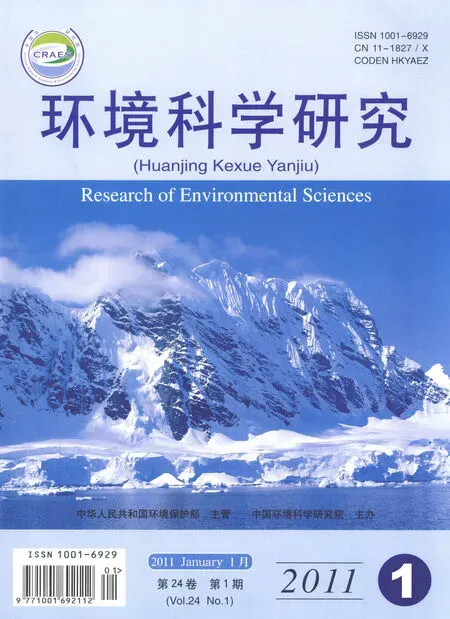保护淡水水生生物硝基苯水质基准研究
吴丰昌,孟 伟*,张瑞卿,2,李会仙,曹宇静,徐冰冰,冯承莲
1.中国环境科学研究院,国家环境保护湖泊污染控制重点实验室,北京 100012
2.中国科学院广州地球化学研究所,广东 广州 510640
保护淡水水生生物硝基苯水质基准研究
吴丰昌1,孟 伟1*,张瑞卿1,2,李会仙1,曹宇静1,徐冰冰1,冯承莲1
1.中国环境科学研究院,国家环境保护湖泊污染控制重点实验室,北京 100012
2.中国科学院广州地球化学研究所,广东 广州 510640
以硝基苯为研究对象,在分析美国和中国2种类型水生态系统和生物区系特征的基础上,分别筛选两国水生生物物种的毒性数据,运用物种敏感度分布曲线法、毒性百分数排序法和评价因子法分别推导了2个国家保护淡水水生生物水质基准;同时,结合国内外主要水体ρ(硝基苯)分布特征,对地表水体中硝基苯生态风险进行了初步评价.结果表明:由于生物区系不同,同样方法得到的美国水质基准值明显高于中国水质基准值,其中物种敏感度分布曲线法得出的基准值最为合理.用物种敏感度分布曲线法得到中国硝基苯急性基准值为0.572 mg/L,慢性基准值为0.114 mg/L;美国硝基苯急性基准值为7.271 mg/L,慢性基准值为2.031 mg/L.风险表征结果显示,中国主要地表水体中硝基苯不存在潜在的生态风险.
硝基苯;水质基准;水生态系统;生物区系;物种敏感度分布法
Abstract:Nitrobenzene was studied through investigations and analysis of two types of aquatic ecosystems and aquatic biota in China and the United States.The species toxicity data in the two countries were selected,and the aquatic life criteria were derived using three methods:species sensitivity distribution curve method,toxicity percentile rank method and the assessment factor method.At the same time,the ecological risk of nitrobenzene to surface water in China was preliminarily assessed by combining the toxicity results with the distribution characteristics of nitrobenzene concentrations in Chinese surface water.The results show that the criteria derived by the same method in the different countries were different due to the differences of aquatic biota.The criteria of the United States were higher than those of China.The species sensitivity distribution method was most reasonable among the three methods.The acute and chronic criteria of China derived using thismethod were 0.572 and 0.114 mg/L,respectively.The acute and chronic criteria of the United States derived from this method were 7.271 and 2.031 mg/L,respectively.The risk assessment showed that nitrobenzene might have no potential adverse effects on Chinese surface waters.
Keywords:nitrobenzene;water quality criteria;aquatic ecosystem;aquatic biota;species sensitivity distribution method硝基苯是化学工业大量使用的化工原料和反 应中间体[1-2].动物试验研究证明,硝基苯具有致癌潜力,是人类可疑致癌物[3].早在1986年,硝基苯就被美国国家环境保护局(US EPA)列入《金皮书》优先控制污染物名单[4];2001年又被欧盟巴塞尔公约列入环境优先控制有毒有机污染物名单.由于在生活和工业中用途广泛,硝基苯通过各种途径进入地表水环境.在荷兰、日本和美国等国家的地表水中已检出了硝基苯[5-7].在中国的各主要水体,如松花江[8]、官厅水库[9]、永定河[9]、淮河[10]、海河[11]、黄河[12-13]和长江[14]中也检出了硝基苯,2005年松花江污染事件中个别点的ρ(硝基苯)曾一度高达1.47 mg/L[15].
针对硝基苯污染,各国都开展了大量毒理学和风险评估等的研究,提出了硝基苯的基准或标准限值.如俄罗斯饮用水硝基苯标准为 0.2 mg/L[16],渔业用水最高限值为0.01 mg/L[17];US EPA在2009年公布的最新《国家推荐水质基准》报告中给出的硝基苯人体健康水质基准值为0.017 mg/L(考虑消费水和生物)和 0.69 mg/L (仅考虑消费生物)[18-19];澳大利亚和新西兰保护水生生物的硝基苯中度可靠触发值为 0.55 mg/L[20];中国 2002年《地表水环境质量标准》(GB 3838—2002)[21]中集中式生活饮用水地表水源地特定项目硝基苯的标准限值为0.017 mg/L.
污染物通常会对人体健康和水生态系统造成不利影响,完整的水质基准体系至少应包括保护人体健康水质基准和保护水生生物水质基准.保护水生生物水质基准是保护水生态系统结构和功能完整的主要依据.虽然国际上对硝基苯人体健康基准开展了较多的研究,颁布了人体健康基准值[18-20],但由于缺乏对硝基苯水生生物水质基准的深入研究,目前尚未能颁布其水生态基准值,因此无法科学地制订针对保护水生态系统的水环境质量标准以及进行水环境质量评价,所以迫切需要开展这方面的研究.
笔者分别针对美国和中国的水生态系统和生物区系特征,使用3种不同的方法推导了保护水生生物硝基苯水质基准值,探讨了生物区系对水生生物水质基准的影响,以期为中国国家水环境质量基准的建立探寻合适的方法,以及为中国硝基苯水质标准制订和环境管理提供科学依据.
1 保护水生生物水质基准指标
目前各国保护水生生物的水质基准普遍采用双值基准体系,如 US EPA推荐的基准最大浓度(CMC)和基准连续浓度(CCC),以及加拿大的短期暴露基准和长期暴露基准[22].考虑到中国的水环境污染状况以及水生生物水质基准保护目标,同样采用双值基准,包括基准最大浓度(即急性水质基准,AWQC)和基准连续浓度(即慢性水质基准,CWQC).急性水质基准是为保护水生态系统和水生生物免受突发性水污染事件中高浓度污染物短期内的急性毒性效应;慢性水质基准是为保护水生态系统和水生生物免受长期暴露于低浓度污染物导致的慢性毒性效应.急性基准值以急性毒性试验数据为依据,慢性基准值以慢性毒性试验结果为依据,它们分别从急性和慢性暴露2个方面对水生态系统结构和功能进行全面保护.
2 研究方法
2.1 物种和数据的筛选
根据水生态系统和生物区系特征,参考《中国脊椎动物大全》[23]和美国《国家保护水生生物及其用途水质基准推导指南》[24](简称“指南”)推荐的淡水物种,分别选择中国和美国物种,所选物种应至少包括藻类或植物、甲壳类和鱼类等3个营养级生物[22-25].收集其急性和慢性毒性数据.急性毒性数据选择48 h或96 hLC50或EC50,慢性数据为慢性暴露试验结果NOEC或LOEC.用于统计模型推导的毒性数据不少于10个[26].
此外,所选毒性研究的毒性试验方法应符合经济合作与发展组织[27-30]、美国试验与材料学会[31]、美国国家环境保护局[32-33]以及中国《国家环境保护化学品测试准则》[34]中发布的标准试验方法.
2.2 水质基准推导方法
2.2.1 物种敏感度分布曲线法
物种敏感度分布曲线法最初是由KOOIJMAN[35]提出的,后来很多学者对其进行了改进,目前在生态风险评价中应用广泛[36].该方法假设从整个生态系统中随机选取物种并获得毒性数据,且假设生态系统中不同物种的毒性数据符合一定概率函数,即“物种敏感度分布”.首先检验所获毒性数据的正态性,然后使用统计模型将污染物浓度和物种敏感性分布的累计概率进行拟合分析,计算可以保护大多数物种的污染物浓度,通常采用5%物种受危险的浓度,即HC5表示,或称作95%保护水平的浓度[26].
急性基准值的推导:将用于推导水质基准的毒性数据按照生物种属分别计算各物种平均急性值(SMAV)和属平均急性值(GMAV)(二者均为几何平均值);将GMAV按照大小排序,并统一编号R(R=1,2,…,N),其中,N为毒性数据的个数;计算每个毒性数据的毒性百分数(累计概率)P,P=R/(N+1);选择分布模型对全部数据的P值和属平均急性值进行拟合分析,推算HC5;急性基准值为HC5的一半[37].
慢性基准值有2种可选推导方法:①当有足够慢性数据用于拟合模型时,可使用与推导急性基准值同样的方法;②如果不能使用模型拟合,则使用急性数据得到的HC5除以急慢性比率(ACR)获得.急慢性比率为至少3个物种的急慢性比率的几何平均值;如果不能计算得出急慢性比率,则默认ACR为10.
2.2.2 毒性百分数排序法
根据US EPA对水质基准意义的论述,如果某化学物质的4天平均浓度超过慢性基准值的次数平均每3年不多于1次,并且其每小时平均浓度超过急性基准值的次数平均每3年不多于1次,那么就认为水生生物及其用途不会受到不可接受的影响.参照“指南”[24]中的推导方法,对P最接近0.05的4个GMAV进行拟合,拟合公式如下:
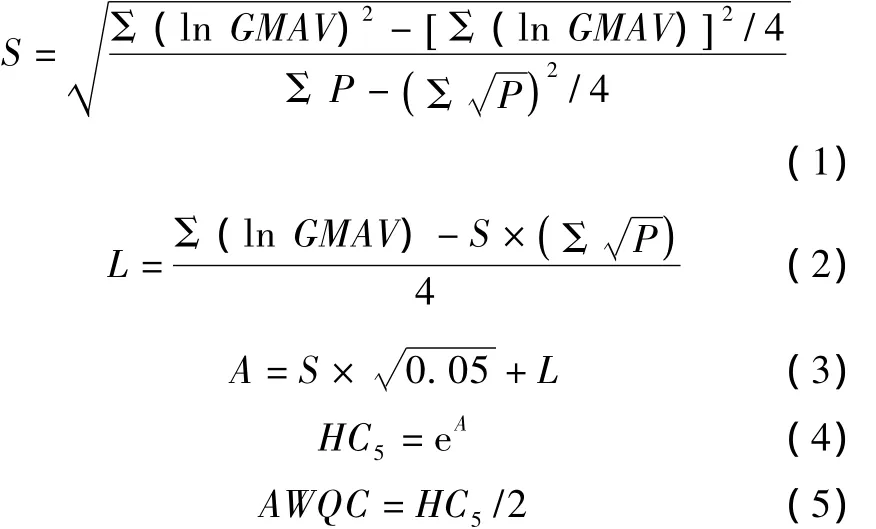
其中,GMAV为属平均急性值;P为毒性百分数.
慢性基准值一般考虑的是污染物对水生动物的慢性毒性效应、对水生植物的毒性效应以及污染物的生物富集效应,它等于最终慢性值、最终植物值和最终残留值中的最小者.从保护水生态系统结构和物种多样性的角度出发,并且考虑到硝基苯的KOW较低,在生物体内的残留不大,在推导水质基准时将水生动物和水生植物综合考虑推导最终慢性值,而不考虑最终残留值.
2.2.3 评价因子法
评价因子法是使用最低毒性值除以适当的评价因子得到一个最终的水质基准单值.该方法选择最低的毒性值作为推导水质基准的依据[22-25].如果最低的毒性值为慢性试验结果NOEC或LOEC,则将该值除以评价因子10;如果最低的毒性值是急性试验结果,则推导水质基准有2种选择:①如果可以得到恰当的ACR,可以使用最低的LC50或EC50除以ACR得到水质基准;②如果没有ACR,可使用最低的LC50或EC50除以评价因子100得到水质基准.评价因子用于表示由于物种、实验室或野外条件和试验终点不同导致的敏感性差别[38-40].
3 结果
3.1 物种和数据
根据物种和数据的筛选原则选出了中国物种的数据,包括裸藻门、绿藻门、脊索动物门、节肢动物门和环节动物门等5门共11科生物的毒性数据(见表1).美国物种数据包括绿藻门、脊索动物门、节肢动物门和软体动物门等4门共15科生物的毒性数据,其中包括了“指南”中毒性试验所要求的8种生物(见表2).中、美两国物种组成有明显差异,鲑科鱼是美国的主要淡水鱼类;而在中国,鲤科鱼为主要淡水鱼类,约占全国渔业产量的1/4~1/3.由图1可以看出,硝基苯对中、美两国物种的毒性大小也有明显差异.
3.2 物种敏感度分布曲线法
3.2.1 中国水生生物硝基苯水质基准
按照2.2.1节的方法分析表1中急性毒性数据显示,幂函数分布模型对毒性数据的拟合效果更好,拟合曲线的R2为0.94(见图2).依据该模型得到HC5为1.144 mg/L,所以硝基苯的急性基准值为0.572 mg/L.由于没有足够数据得出中国物种的硝基苯急慢性比率,所以将HC5除以ACR的默认值 10得出硝基苯慢性基准值为 0.114 mg/L.
3.2.2 美国水生生物水质基准
使用不同的分布模型对表2中的急性毒性数据进行拟合分析显示,对数正态分布模型拟合效果最佳(见图3),拟合曲线的R2为0.98.依据该模型得到保护 95%水生物种的HC5为 14.543 mg/L,所以硝基苯的急性基准值为7.271 mg/L.
使用黑头呆鱼(Pimephales promelas)[63]、斑马鱼(Danio rerio)[46]和大型蚤(Daphnia magna)[55]的急慢性毒性数据得到硝基苯的急慢性比率为
7.16.将HC5(14.543 mg/L)除以急慢性比率得到硝基苯慢性基准值为2.031 mg/L.

表1 推导中国硝基苯水质基准的毒性数据Table 1 Toxicity data for deriving Chinese water quality criteria of nitrobenzene
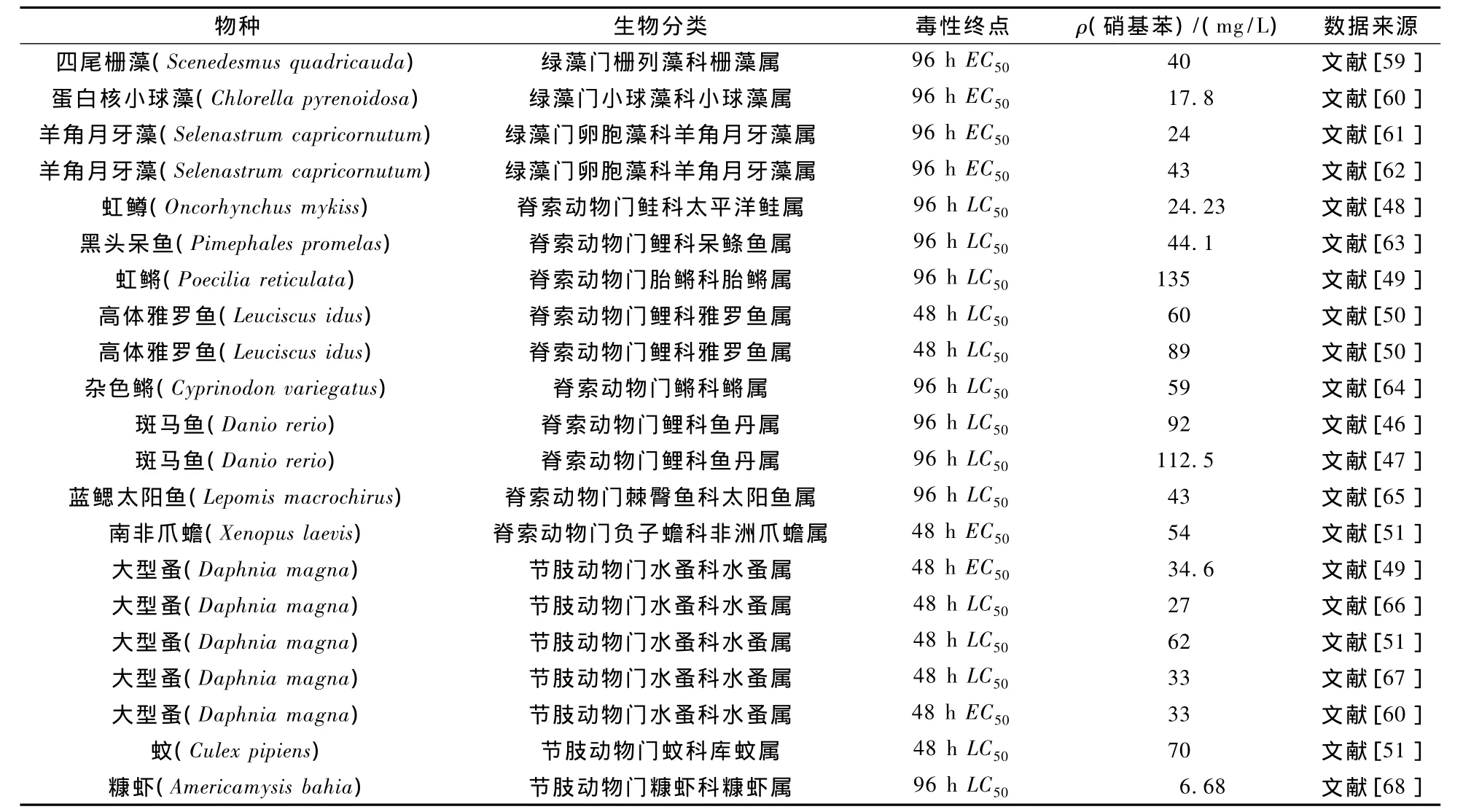
表2 推导美国硝基苯水质基准的毒性数据Table 2 Toxicity data for deriving United State water quality criteria of nitrobenzene
3.3 毒性百分数排序法
3.3.1 中国水生生物水质基准
使用2.2.2节中的方法分析硝基苯对中国物种的急性毒性数据(见表1),最敏感的4个属为鲤属、青鳉属、栅藻属和太平洋鲑属.依据式(1)~(4)推导得出硝基苯HC5值为1.611 mg/L,据此得出硝基苯的急性水质基准值为0.805 mg/L,慢性水质基准值为0.161 mg/L(见图4).

续表2

图1 硝基苯对中国和美国物种的毒性效应对比Fig.1 Comparison of toxicity of nitrobenzene to species of China and United State
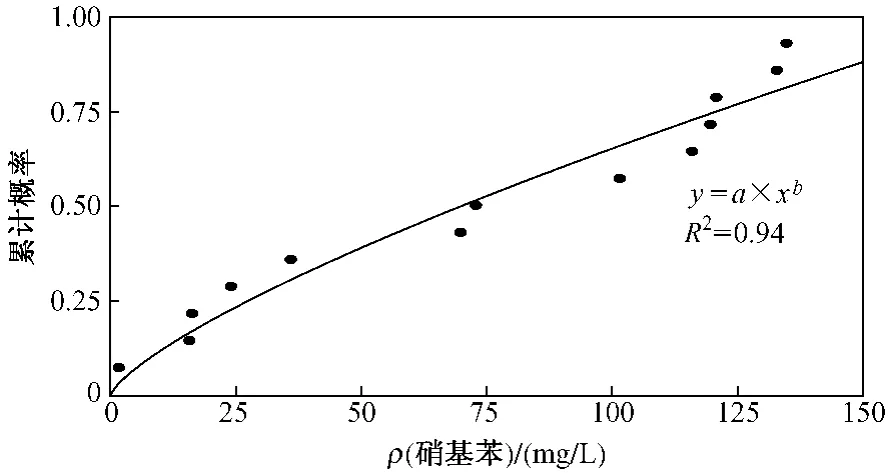
图2 中国硝基苯急性毒性数据拟合曲线Fig.2 Fitting curve of nitrobenzene acute toxicity data of China

图3 美国硝基苯急性毒性数据拟合曲线Fig.3 Fitting curve of nitrobenzene acute toxicity data of United State
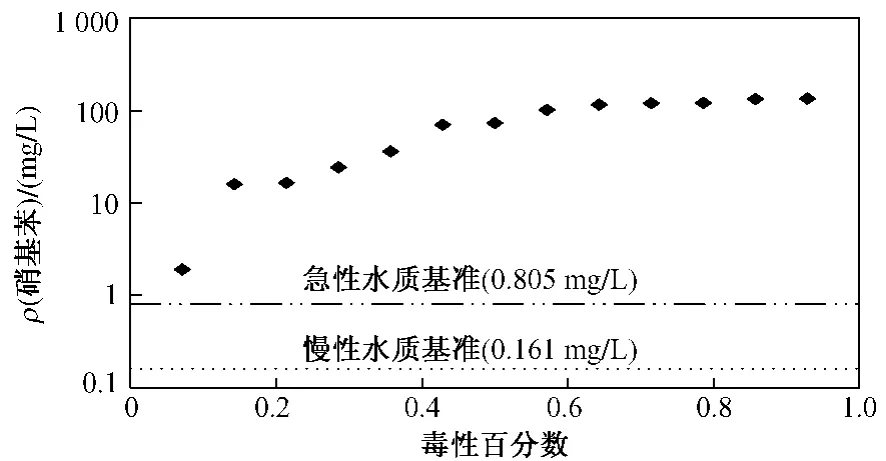
图4 毒性百分数排序法推导的中国硝基苯水生生物水质基准Fig.4 The aquatic life water quality criteria of nitrobenzene for China derived by toxicity percentile rank method
3.3.2 美国水生生物水质基准
使用表 2中急性毒性数据和 2.2.2节的方法,得出美国数据中最敏感的4个属为蛙属、糠虾属、太平洋鲑属和水蚤属.依据这4个属的数据推导得出硝基苯的HC5为6.289 mg/L,依据该值及硝基苯急慢性比率得出硝基苯的急性水质基准值为3.145 mg/L,慢性水质基准值为0.878 mg/L (见图5).
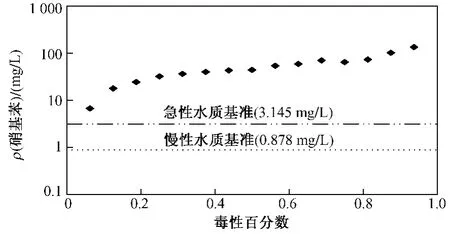
图5 毒性百分数排序法推导的美国硝基苯水生生物水质基准Fig.5 The aquatic life water quality criteria of nitrobenzene for United State derived by toxicity percentile rank method
3.4 评价因子法
3.4.1 中国水生生物水质基准
在表1的毒性数据中青鳉的48 hLC50为最低的毒性值[44],该值为急性毒性数据,所以取100作为评价因子,得出硝基苯水质基准值为 0.018 mg/L.选取次敏感生物鲤鱼的96 hLC50[43]推导得出的水质基准为0.019 mg/L.
3.4.2 美国水生生物水质基准
在表2所有急性和慢性毒性数据中,最低毒性值为豹蛙(Rana pipiens)的 9 dLC50(0.64 mg/L).在BLACK等[69]的研究中,将豹蛙(Rana pipiens)从受精卵到孵化后4 d持续暴露在硝基苯溶液中,总暴露时间为 9 d,暴露浓度为 0.001,0.01,0.05,0.10,0.41和1.27 mg/L,以孵化时的死亡率LC50作为毒性终点,自暴露起始的 1.27 mg/L至暴露结束时的0.64 mg/L.由于该毒性试验选用的受试生物处于受精卵及胚胎阶段,对于毒性效应较为敏感,且暴露时间较长,所以将其试验结果9 dLC50确定为慢性毒性值.选择该结果作为推导水质基准的关键依据,评价因子选择10,得出硝基苯水质基准为0.064 mg/L.
4 讨论
利用3种方法分别计算了淡水水生生物硝基苯的水质基准,结果发现,3种方法推导出的基准值存在差异(见表3).通过评价因子法得出的水质基准值最低,美国为0.064 mg/L,中国为0.018 mg/L.评价因子法得出的基准值很可能会对水生态系统造成保护过度,但是在没有基准值且毒性数据较少情况下,通过该方法推导某些污染物的水质基准对于水质管理仍非常重要.有研究认为,由于毒性百分数排序法在推导水质基准时仅使用了4个最敏感属的毒性数据,其中个别毒性数据可能与其他数据间差异较大,从而会得出有偏颇的水质基准值;而物种敏感度分布曲线法在推导水质基准值时考虑了全部数据,推导得出的基准值与全部物种的敏感性分布有很好的一致性,更具有统计学意义[70].

表3 硝基苯水生生物水质基准Table 3 The aquatic life water quality criteria of nitrobenzene
由表3可以看出,使用相同方法推导的中、美两国水质基准值存在明显差异,美国水质基准值均明显高于中国.毒性百分数排序法和评价因子法推导的美国水质基准是中国水质基准的3倍以上;物种敏感度分布曲线法得出的美国急性基准值是中国的10倍多,慢性基准值是中国的20倍左右.这种差异主要来自中、美两国水生态系统和生物区系特征的差异.
比较中国地表水源标准限值,该研究中得到的急、慢性基准值以及世界各区域地表水中检测的ρ(硝基苯),由图 6可看出,所有地表水中ρ(硝基苯)均低于该研究中得到的急、慢性基准值,只有多瑙河和中国的官厅水库、海河ρ(硝基苯)高于目前中国地表水源标准限值.但是,2005年松花江水污染事件中,不同河段的ρ(硝基苯)达到了0.167~1.47 mg/L[15],超过了物种敏感度分布曲线法推导的中国硝基苯慢性基准值,最高浓度为急性水质基准值(0.572 mg/L)的2倍.在污水团通过特定监测断面前后浮游动植物群落结构也发生一定变化[71],这表明污染事件中硝基苯有较大的生态风险.
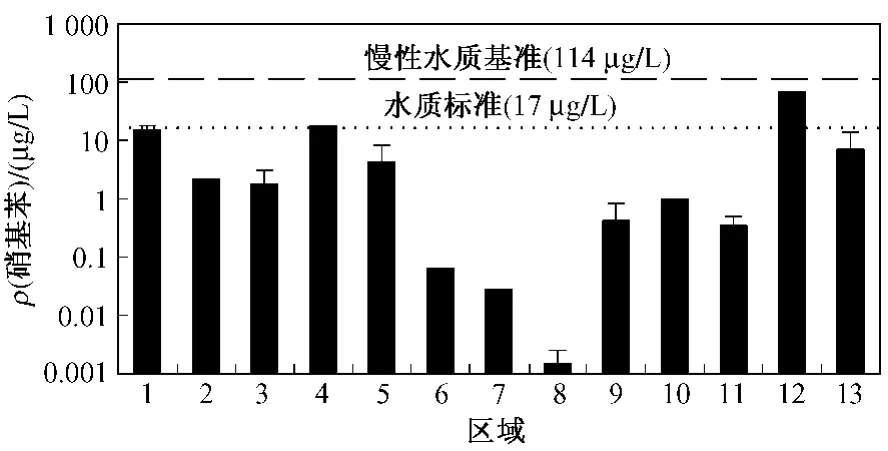
图6 已报道的地表水中ρ(硝基苯)Fig.6 The reported concentration of nitrobenzene in surface water
5 结论
a.水质基准具有明显的区域性,水生态系统和生物区系特征对水质基准有明显影响.该研究和其他最新研究均表明:在水质基准推导过程中,物种敏感度分布曲线法可能优于毒性百分数排序法和评价因子法,得出的水质基准值更具有统计学意义.使用物种敏感度分布曲线法得到的美国硝基苯急性水质基准值为7.271 mg/L,慢性基准值为 2.031 mg/L;中国硝基苯急性水质基准为0.572 mg/L,慢性水质基准基准值为0.114 mg/L.
b.目前世界其他地区和中国主要水体中ρ(硝基苯)均不超过慢性和急性水生态基准值,说明硝基苯总体上对水生生物不存在潜在的生态风险.
[1]ZHOU Q F,FU J J,MENG H Z,et al.Subchronic toxicological effects of aquatic nitrobenzene on Medaka and Chinese rare minnow[J].Science in China Series B: Chemistry,2007,50(5):707-717.
[2]World Health Organization.Environmental health criteria 230 nitrobenzene[R]. Geneva:World Health Organization,2003.
[3]US EPA.Proposed guidelines for carcinogen risk assessment[R].Federal Register,1996,61(79):17960-18011.
[4]US EPA.Quality criteria for water[R].Washington DC: Office ofWater Regulations and Standards,1986.
[5]NOORDSIJA,PUYKER L M,VAN DER GAAG M A.The quality of drinkingwater prepared from bank-filtered riverwater in the Netherlands[J].Sci Total Environ,1985,47:273-292.
[6]YAMAGISHIT,M IYAZAKI T.Identification of musk xylene and musk ketone in fresh water fish collected from the tama river Tokyo[J].Bulletin of Environmental Contamination and Toxicology,1981,26(10):656-662.
[7]YURAWECZ M P,PURNA B J.Nitro musks fragrances as potential contaminants in pesticide reside analysis[J].Journal Association of Official Analytical Chemists,1983,66(4):241-247.
[8]郎佩珍,龙凤山,袁星,等.松花江中游(哨口—松花江村段)水中有毒有机物污染研究[J].环境科学进展,1993,1 (6):47-55.
[9]康跃惠,宫正宇,王子健,等.官厅水库及永定河水中挥发性有机物分布规律[J].环境科学学报,2001,21(4):338-343.
[10]王子健,吕怡兵,王毅,等.淮河水体取代苯类污染及其生态风险[J].环境科学学报,2002,22(3):300-304.
[11]王宏,杨霓云,沈英娃,等.海河流域几种典型有机污染物环境安全性评价[J].环境科学研究,2003,16(6):35-36,52.
[12]胡国华,赵沛伦.黄河孟津—花园口区间有机污染分析及防治对策[J].人民黄河,1995(11):6-9.
[13]HE M C,SU Y,LI X R,et al.Distribution patterns of nitrobenzenes and polychlorinated biphenyls in water,suspended particulate matter and sediment from mid-and down-stream of the Yellow River(China)[J].Chemosphere,2006,65:365-374.
[14]田怀军,舒为群,张学奎,等.长江、嘉陵江(重庆段)源水有机污染物的研究[J].长江流域资源与环境,2003(12): 118-123.
[15]LEIB L,HUANG S B,QIAO M,et al.Prediction of the environmental fate and aquatic ecological impact of nitrobenzene in the Songhua River using the modified AQUATOX model[J].JEnviron Sci,2008(20):769-777.
[16]Russian Ministry of Health.Water quality standards of drinking water and centralized water supply system,water quality monitoring and quarantine norms and standards[R].Moscow: Russian Ministry of Health,2001.
[17]Russian Ministry of Agriculture Fisheries Agency.Russian federation state committee on fisheries decree 96,list of highest concentration of harm ful substances and security levels in fishery waters[R].Moscow:Russian Ministry of Agriculture Fisheries Agency,1999.
[18]US EPA.National recommended water quality criteria[R]. Washington DC:Office of Water,Office of Science andTechnology,2006.
[19]US EPA.National recommended water quality criteria[R]. Washington DC:Office of Water,Office of Science and Technology,2009.
[20]ANZECC,ARMCANZ.Australian and New Zealand guidelines for fresh and marine water quality[R].Canberra,Australia: Australia and New Zealand Environment and Conservation Council and Agriculture and Resource Management Council of Australia and New Zealand,2000.
[21]国家环境保护总局.GB 3838—2002地表水环境质量标准[S].北京:中国标准出版社,2002.
[22]Canadian Council of Ministers of the Environment(CCME).A protocol for the derivation of water quality guidelines for the protection of aquatic life[R].W innipeg,Manitoba:Canadian Council of Ministers of the Environment,2007.
[23]刘明玉,解玉浩,季达明.中国脊椎动物大全[M].沈阳:辽宁大学出版社,2000.
[24]STEPHAN C E,MOUNT D I,HANSEN D J,et al. Guidelines for deriving numerical national water quality criteria for the protection of aquatic organisms and their uses[R].US EPA Report No.PB-85-227049.Washington DC:US EPA,1985.
[25]Canadian Council of Ministers of the Environment(CCME).A protocol for the derivation of water quality guidelines for the protection of aquatic life[R].W innipeg,Manitoba:Canadian Council of Ministers of the Environment,1999.
[26]WHEELER JR,GRIST E PM,LEUNG K M,et al.Species sensitivity distributions:data and model choice[J].Marine Pollution Bulletin,2002,45:192-202.
[27]Organization for Economic Co-operation and Development (OECD).OECD guideline for testing of chemicals test guideline 203 fish,acute toxicity test[R].Paris,France: OECD Environment Directorate,1992.
[28]Organization for Economic Co-operation and Development (OECD).OECD guideline for testing of chemicals test guideline 210 fish,early-life stage toxicity test[R].Paris,France:OECD Environment Directorate,1992.
[29]Organization for Economic Co-operation and Development (OECD).OECD guideline for testing of chemicals test guideline 202 Daphnia sp.,acute immobilization test[R]. Paris,France:OECD Environment Directorate,2004.
[30]Organization for Economic Co-operation and Development (OECD).OECD guideline for testing of chemicals test guideline 201 freshwater alga and cyanobacteria, growth inhibition test[R].Paris,France:OECD Environment Directorate,2006.
[31]American Society for Testing and Materials(ASTM).Standard guide for conducting acute toxicity tests with fishes,macroinvertebrates,and amphibians.E729-96[M]//Annual book of ASTM standards,vol.11.05.Philadelphia:ASTM,1997.
[32]US EPA.Trimmed-Spearman-Karber estimation of LC50values user's manual[R].Athens,Georgia:US EPA,Office of Research and Development, National Exposure Research Laboratory-Ecosystems Research Division,Center for Exposure Assessment Modeling(CEAM),1999.
[33]US EPA.Methods formeasuring the acute toxicity of effluents and receiving waters to freshwater and marine organisms[R]. Washington DC:US EPA,Office ofWater,2002.
[34]闫雷生.国家环保局化学品测试准则[M].北京:化学工业出版社,1990:189-196.
[35]KOOIJMAN S A L M.A safety factor for LC50values allowing for differences in sensitivity among species[J].Water Res,1987,21:269-276.
[36]United States Environmental Protection Agency(US EPA). Guidelines for ecological risk assessment[R].EPA 630-R-95-002F.Washington DC:US EPA,1998.
[37]SCHULER L J,RAND G M.Aquatic risk assessment of herbicides in freshwater ecosystems of south Florida[J]. Archives of Environmental Contamination and Toxicology,2008,54:571-583.
[38]KIMERLE R A.Has the water quality criteria concept outlived its usefulness[J].Environ Toxicol Chem,1986,5:113-115.
[39]MAYER F L,MAYER K S,ELLERSIECK M R.Relation of survival to other endpoints in chronic toxicity tests with fish[J].Environ Toxicol Chem,1986,5:737-748.
[40]MAYER F L,ELLERSIECK M R.Experiences with singlespecies tests for acute toxic effects on freshwater animals[J]. Ambio,1988,17:367-375.
[41]朱小燕,邓凤霞.硝基苯在纤细裸藻中的毒性和降解吸附[J].华中师范大学研究生学报,2006,13(1):156-158.
[42]王宏,沈英娃,卢玲,等.几种典型有害化学品对水生生物的急性毒性[J].应用与环境生物学报,2003,9(1):49-52.
[43]YEN J H,LIN K H,WANGY S.Acute lethal toxicity of environmental pollutants to aquatic organisms[J].Ecotoxicol Environ Saf,2002,52:113-116.
[44]YOSHIOKA Y,OSE Y,SATO T.Correlation of the five test methods to assess chemical toxicity and relation to physical properties[J].Ecotoxicol Environ Saf,1986,12(1):15-21.
[45]卢玲,沈英娃.酚类、烷基苯类、硝基苯类化合物和环境水样对剑尾鱼和稀有鮈鲫的急性毒性[J].环境科学研究,2002,15(4):57-59.
[46]RODERER G.Testung wassergefahrdender stoffe als grundlage fur wasserqualitatsstandards [R]. Testbericht: Wassergefahrdende Stoffe.Schmallenberg:Fraunhofer-Institut fur Umweltchemie und Okotoxikologie,1990.
[47]WELLENS H.Comparison of the sensitivity of brachydanio rerio and leuciscus idus by testing the fish toxicity of chemicalsand wastewaters[J].Z Wasser-Abwasser-Forsch,1982,51 (2):49-52.
[48]CASTANO A,CANTARINO M J,CASTILLO P,et al. Correlations between the RTG-2 cytotoxicity test EC50and in vivo LC50rainbow trout bioassay[J].Chemosphere,1996,32 (11):2141-2157.
[49]RAMOS E U,VERMEER C,VAES W H J.et al.Acute toxicity of polar narcotics to three aquatic species(Daphnia magna,Poecilia reticulata and Lymnaea stagnalis)and its relation to hydrophobicity[J].Chemosphere,1998,37(4): 633-650.
[50]JUHNKE I,LUEDEMANN D.Results of the investigation of 200 chemical compounds for acute fish toxicity with the golden orfe test(Ergebnisse der untersuchung von 200 chemischen verbindungen auf akute fischtoxizitat mit dem goldorfentest)[J].ZWasser-Abwasser-Forsch,1978,11(5):161-164.
[51]CANTON J H,SLOOFF W,KOOL H J,et al.Toxicity,biodegradability and accumulation of a number of Cl/N-containing compounds for classification and establishing water quality criteria[J].Regulatory Toxicology and Pharmacology,1985,5:123-131.
[52]王阳峰,吕玉新.用水生态毒理学方法评价13种硝基苯类化合物的急性毒性[J].新乡医学院学报,2004,21(6): 456-457.
[53]陆光华,金琼贝,王超.硝基苯类化合物对隆线蚤急性毒性的构效关系[J].河海大学学报:自然科学版,2004,32(4): 372-375.
[54]刘祎男,范学铭,阚晓微,等.苯、苯酚、硝基苯对水丝蚓的急性毒性及超氧化物歧化酶活性的影响[J].水生生物学报,2008,32(3):420-423.
[55]KUHN R.Schadstoffwirkungen von umweltchemikalien im daphnien-reproduktions-test als grund lage fr die bewertung der umweltgefhrlichkeit in aquatischen sys[R].Forschungsbericht 10603052,M rz.Berlin Dahlem:Institut für Wasser-,Bodenu,1988(OECD Data File).
[56]KUEHN R,PATTARD M,PERNAK K D,et al.Results of the harm ful effects of water pollutants to Daphnia magna in the 21 day reproduction test[J].Water Res,1989,23(4):501-510.
[57]BRINGMANN G,KUHN R.Limiting values for the noxious effects of water pollutant material to blue algae(Microcystis aeruginosa)and green algae(Scenedesmus quadricauda)in cell propagation inhibition tests Grenzwerte der Schadwirkung Wasse[J].Vom Wasser,1978,50:45-60.
[58]RAMOS E U,VAESW H J,MAYER P,et al.Algal growth inhibition of chlorella pyrenoidosa by polar narcotic pollutants: toxic cell concentrations and QSAR modeling[J].Aquatic Toxicology,1999,46(1):1-10.
[59]BRINGMANN G,KUHN R.Comparative water-toxicological investigations on bacteria, algae, and daphnia [J]. Gesundheits-Ingenieur,1959,80(4):115-120.
[60]DENEER JW,VAN LEEUWEN C J,SEINEN W,et al. QSAR study of the toxicity and bioconcentration factor of nitrobenzene derivatives towards Daphnia magna,Chlorella pyrenoidosa and Photobacterium phosphoreum[J].Aquatic Toxicology,1989,15:83-98.
[61]BOLLMAN M A,BAUNE W K,SMITH S,et al.Report on algal toxicity tests on selected office of toxic substances(OTS) chemicals[R].Corvallis OR:US EPA,1989:186.
[62]US EPA.Ambientwater quality criteria for nitrobenzene[R]. Washington DC:US EPA,1980.
[63]MARCHINIS,TOSATO M L,NORBERG-KING T J,et al. Lethal and sublethal toxicity of benzene derivatives to the fathead minnow,using a short-term test[J].Environ Toxicol Chem,1992,11(2):187-195.
[64]HEITMULLER P T,HOLLISTER T A,PARRISH P R.Acute toxicity of 54 industrial chemicals to sheepshead minnows (Cyprinodon variegatus)[J].Bull Environ Contam Toxicol,1981,27(5):596-604.
[65]BUCCAFUSCO R J,ELLS S J,LEBLANC G A.Acute toxicity of priority pollutants to bluegill(Lepomismacrochirus)[J].Bull Environ Contam Toxicol,1981,26(4):446-452.
[66]LEBLANC G A.Acute toxicity of priority pollutants to water flea(Daphnia magna)[J].Bull Environ Contam Toxicol,1980,24(5):684-691.
[67]MAAS-DIEPEVEEN J L,VAN LEEUWEN C J.Aquatic toxicity of aromatic nitro compounds and anilines to several freshwater species[R].Report No.86-42.Dutch:Laboratory for Ecotoxicology,Institute for Inland Water Management and Waste Water Treatment,1986:10.
[68]US EPA.In-depth studies on health and environmental impacts of selected water pollutants[R].Duluth MN:US EPA,1978.
[69]BLACK JA,BIRGE W J,MCDONNELL W E,et al.The aquatic toxicity of organic compounds to embryo–larval stages of fish and amphibians[R].Lexington,Kentucky:University of Kentucky,Water Resources Research Institute,1982.
[70]DANIEL JF,DENNIST B,LANCE T Y,et al.Derivation of acute ecological risk criteria for chlorite in freshwater ecosystems[J].Water Res,2003,37(18):4359-4368.
[71]黄钰.硝基苯污染对松花江浮游生物影响的研究[D].长春:东北师范大学,2007.
[72]GAO J J,LIU L H,LIU X R,et al.Concentration level and geographical distribution of nitrobenzene in Chinese surface waters[J].JEnviron Sci,2008,20(7):803-805.
[73]ROBERT G,HEINRICH H,GERHARD R,et al.The distribution of nitrobenzene and other nitroaromatic compounds in the North Sea[J].Marine Pollution Bulletin,1995,30 (3):221-228.
[74]KUHNW,CLIFFORD D.Experience with specific organic analysis for water quality control in West Germany[C]// Proceedings of the 13 th American Water Works Association Water Quality Technology Conference.Denver,Colorado: American Water Works Association,1986:353-363.
[75]ZOETEMAN B C J,HARMSEN K,LINDERS JB H J,et al. Persistent organic pollutants in river water and ground water of the Netherlands[J].Chemosphere,1980,9:231-249.
[76]MALLEVIALLE J,BRUCHET A,SCHM ITT E.Nitrogenous organic compounds:identification and significance in several French water treatment plants[C]//Proceedings of the 11 th American water works association water quality technology conference. Denver, Colorado:American Water Works Association,1984:83-96.
[77]HAIN Z,DALMACIJA B,MISKOVIC D,et al.Preparation of drinking water from the surface water of the Danube:a case study[J].Water Sci Technol,1990,22:253-258.
[78]WAGGOT A,WHEATLAND A B.Contribution of different sources to contamination of surface waters with specific persistent organic pollutants[M/C]//HUTZINGER O,VAN LEYLYVELD I H,ZOETEMAN B C J,et al.Aquatic pollutants:transformation and biological effects.Proceedings of the 2nd International Symposium on Aquatic Pollutants,Noordwijkerhout.Amsterdam:Pergamon Press,1978.
声明
为适应我国信息化建设,扩大本刊及作者知识信息交流渠道,本刊已被《中国学术期刊网络出版总库》及CNKI系列数据库,以及“万方数据资源系统——数字化期刊群”和“龙源国际名刊网”等检索信息系统收录,其作者文章著作权使用费与本刊稿酬一次性给付.如果作者不同意文章被收录,请在来稿时向本刊做出纸面声明,本刊将做适当处理.
《环境科学研究》编辑部
Aquatic Life Water Qua lity Criteria for Nitrobenzene in Freshwater
WU Feng-chang1,MENG Wei1,ZHANG Rui-qing1,2,LI Hui-xian1,CAO Yu-jing1,XU Bing-bing1,FENG Cheng-lian1
1.State Environmental Protection Key Laboratory for Lake Pollution Control,Chinese Research Academy of Environmental Sciences,Beijing 100012,China
2.Guangzhou Institute of Geochemistry,Chinese Academy of Sciences,Guangzhou 510640,China
X-65
A
1001-6929(2011)01-0001-10
2010-07-21
2010-09-28
国 家 重 点 基 础 研 究 发 展 计 划 (973)项 目(2008CB418200)
吴丰昌(1965-),男,浙江衢州人,研究员,博士,博导,主要从事环境地球化学和水质基准研究,wufengchang@vip.sk leg.cn.
*责任作者,孟伟(1956-),男,山东青岛人,研究员,博导,中国工程院院士,主要从事流域水环境管理研究,mengwei@craes.org.cn

